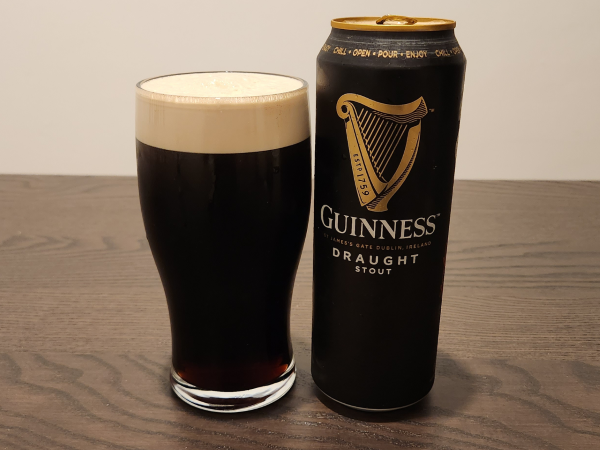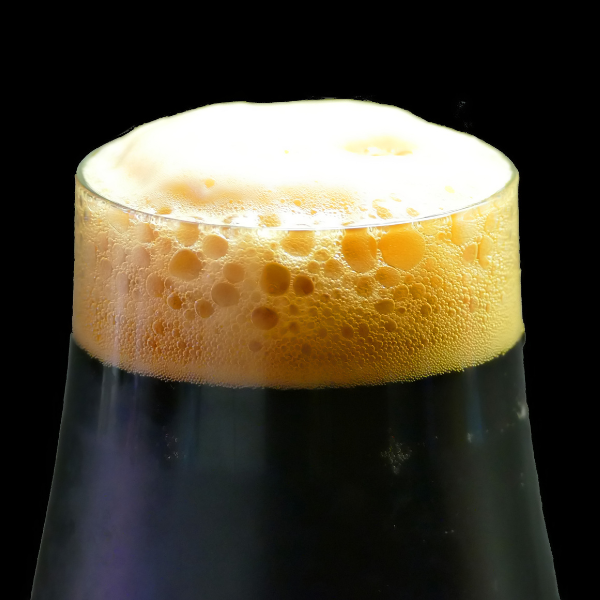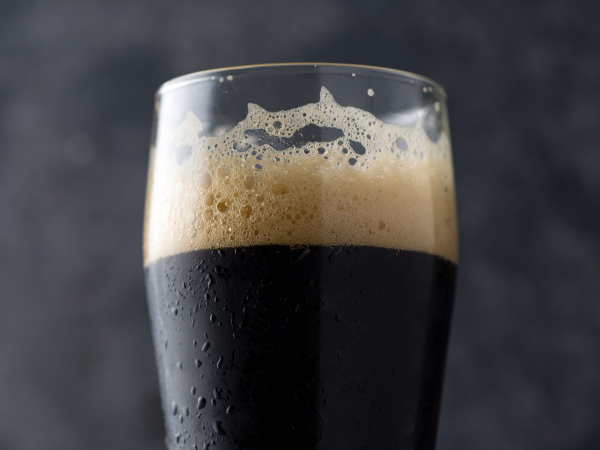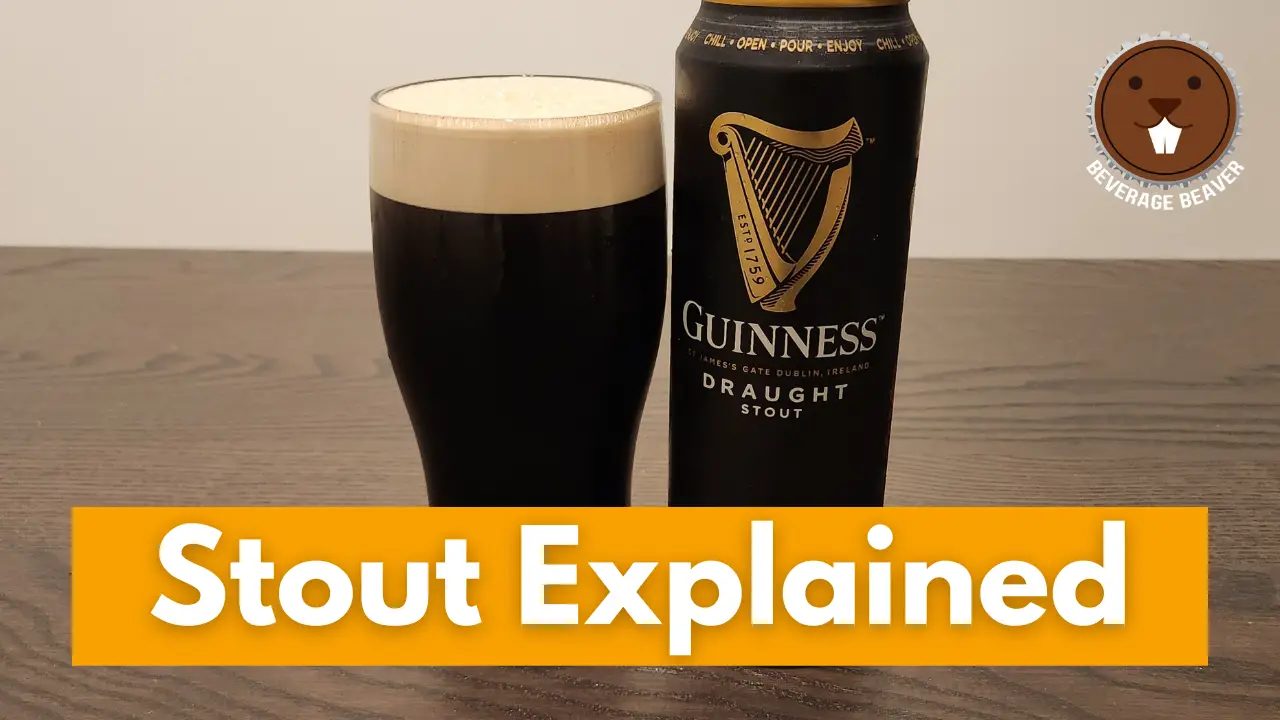Stout Explained: An Easy guide To The Fascinating World Of Stout Beer
When I tried stout for the first time (many years ago) I was so taken aback by the rich, creamy flavor that I simply had to learn more about this truly unique style of beer. Having now sampled a variety of different stouts, from dry stouts like Guinness to the super strong Imperial Stouts, and having even brewed some myself, I can tell you that this beer style is truly fascinating. In this guide, I will explain exactly what stouts are, the different types of stout, and how stouts compare to other dark beer styles like Dunkel, Bock, Schwarzbier, and Porter. Let’s get started.
What Is A Stout?
A stout is a dark, full-bodied beer with a strong flavor profile characterized by roasted malt or roasted barley, hops, water, and yeast. Typically showcasing a balance between sweetness and bitterness, stouts come in several varieties, including dry stout, sweet/milk stout, oatmeal stout, and Imperial stout, each offering distinct qualities from coffee-like aromas to rich, creamy textures.

How Are Stouts Brewed?
Stouts are ales and so they are brewed in a similar way to other ale beers using top-fermenting yeast which ferment at warm temperatures. This results in a quick fermentation process that, along with the use of roasted malts or barley, helps to contribute to the rich, complex flavor profile of stouts. Here’s an overview of the steps taken to brew stouts.
Step 1: Milling
The first step in brewing stouts is the milling phase in which malted grains, often barley, are broken down into smaller pieces to enable the extraction of fermentable sugars during the subsequent mashing phase. For stouts, a portion of the grain bill includes deeply roasted malt or barley, which provides the deep color and characteristic coffee and chocolate flavors.
Step 2: Mashing
Next, the milled grains are transferred to a mash tun, where they are mixed with hot water to create a mash. This process activates natural enzymes in the malt that convert the starches to fermentable sugars, resulting in a sweet liquid called wort. The temperature of the mash also plays a critical role in determining the stout’s body and sweetness.
Step 3: Boiling
After mashing, the wort is transferred to the brew kettle to boil, at which point hops are introduced. In stouts, hops primarily provide a balancing bitterness to counteract the malt’s sweetness, rather than imparting prominent hoppy flavors. Brewers may also introduce other flavoring agents during this phase, such as chocolate or coffee, especially in specialty craft stouts.
Step 4: Fermentation
After boiling, the wort is rapidly cooled and transferred to a fermentation vessel. At this stage, yeast is introduced. Stouts, like all ales, utilize top-fermenting yeast strains that operate at warmer temperatures, facilitating a quicker fermentation process. During fermentation, the yeast consumes the sugars, producing alcohol and carbon dioxide as by-products.
Step 5: Maturation
Once fermentation has finished, the beer still isn’t quite ready for consumption. It must first go through the maturation phase to help the flavors meld together and allow any undesirable harsh tones to soften.
Step 6: Final Preperation
After maturation, the stout may undergo additional carbonation if it hasn’t naturally reached the desired level during fermentation. The beer is also filtered to remove any remaining solid residues. Once these final steps are complete, the stout is ready to be bottled and, subsequently, enjoyed.

What Are The Different Types Of Stout?
There are many different types of stout including Dry Stout, Sweet Stout, Oatmeal Stout, Russian Imperial Stout, and Milk Stout. Each of these vary in terms of taste, texture, and alcohol content. Let’s look at each type of stout in more detail.
Dry Stout
Dry Stout, often known as Irish Stout, is characterized by its dark color and roasted, almost burnt, coffee-like flavor. It’s typically lighter in body and lower in alcohol content, with an emphasis on the bitterness from roasted barley. An example of a Dry Stout is Guinness Draught.
Sweet Stout
Also known as Milk Stout or Cream Stout, Sweet Stout is brewed with lactose, which yeast cannot ferment, contributing to the beer’s residual sweetness. It features a dark color with a sweet, creamy, and full-bodied taste, and a slight roastiness. Left Hand Brewing Company’s Milk Stout Nitro is a good example of a Sweet Stout.
Oatmeal Stout
Oatmeal Stout contains a portion of oats in the grain mix, offering a smooth texture and a hint of sweetness. It’s known for its dark color, mild roastiness, and a creamy, velvety mouthfeel. Samuel Smith’s Oatmeal Stout is a classic example of this type.
Russian Imperial Stout
Russian Imperial Stout is bold, with high alcohol content and intense flavors of roasted malt, chocolate, and often dark fruit. It’s dark in color, full-bodied, and features a balance between sweetness and bitterness. A renowned example is the North Coast Brewing Company’s Old Rasputin.
Chocolate Stout
These stouts are notable for their distinct chocolate flavor, achieved through the use of darker, more aromatic malt that has been roasted or kilned until it acquires a chocolate color. A good example of a Chocolate Stout is Young’s Double Chocholate Stout.
American Stout
These are generally more robust than their Irish counterparts, often featuring notes of coffee, caramel, and dark chocolate with a significant American hop character. An example of an American Stout is Sierra Nevada Stout.
Coffee Stout
Infused with coffee, these stouts have pronounced roasted coffee notes that can range from sweet espresso to bitter coffee grounds. An example of this type of stout is Founders Breakfast Stout.
Pastry Stout
A relatively new style, these stouts are often brewed with ingredients such as chocolate, vanilla, and other dessert-like ingredients, mimicking the flavors of various pastries.
Nitro Stout
Nitro Stouts are brewed with the same ingredients as normal stouts, but instead of carbon dioxide, nitrogen is used. This creates a stout with a much creamier and smoother mouthfeel. An example of a Nitro Stout would be Murphy’s Irish Stout.
Stouts Compared To Other Dark Beers
By now, you should have a good understanding of what a stout is, how it’s brewed, and the different types of stout out there. Now let’s take a look at how stouts compare to other dark beer styles.
Stout Vs Porter
Stouts and porters are both dark, flavorful beers that share a common history, with stout originally having been used to describe a stronger version of porter. Over time, however, the distinctions have become more nuanced, and the beers have evolved into two distinct styles.
Porters, originating from London in the 18th century, are made from malted barley and are known for their sweet, caramel, and toffee notes with hints of roasted grain. They tend to be lighter in both flavor and alcohol content compared to stouts. The roasted flavors in porters are typically derived from the use of brown malt, giving them a chocolate-like, slightly smoky character without the strong bitterness found in many stouts.

Stouts, on the other hand, are distinguished by a dominant roasted barley flavor that lends a coffee-like quality to the beer, accompanied by a notable bitterness from both the roasted grains and a higher hop content. This beer style, while rooted in the porter tradition, generally presents a richer, creamier, and fuller body than porters, often with a higher alcohol content.
The stout category also encompasses a wider variety of sub-styles, like milk stouts, oatmeal stouts, and imperial stouts, each offering unique flavor profiles and textures.
Despite these differences, the lines between stouts and porters can still be somewhat blurry, as individual interpretations by different breweries may lead to overlapping characteristics between the two styles.
Stout Vs Schwarzbier
Schwarzbier, also known as “black beer,” is a traditional German-style lager that, despite its dark color, is very different from stouts. Schwarzbiers are known for their mild roasted flavors, showcasing subtle hints of chocolate or coffee, without the heavy bitterness often associated with the roasted malts of stouts.
They maintain a light to medium body with a clean and crisp mouthfeel, typical of lagers, due to the bottom-fermenting lager yeast and colder fermentation temperatures. The color of Schwarzbier is deep and dark, often akin to a stout, but the similarities largely end there. Schwarzbiers are usually less alcoholic, ranging from 4% to 5% ABV, and feature a malt-driven sweetness and complexity without the astringency or robust bitterness found in many stouts.
Stouts, in contrast, are characterized by their use of top-fermenting ale yeast, higher fermentation temperatures, and significant quantities of roasted barley, leading to a more pronounced bitterness and a fuller body than Schwarzbier.
The stout’s flavor profile is dominated by the roasted malts, offering notes of coffee, chocolate, and sometimes burnt or smoky characteristics, along with a creamier, richer mouthfeel and often a higher alcohol content.
While both Schwarzbier and stouts share a dark appearance, their flavor profiles, mouthfeel, and brewing processes are distinctly different, with stouts presenting a more robust taste experience and Schwarzbier offering a subtler, smoother, and more sessionable drinking experience.
Stout Vs Dunkel
Dunkel, a traditional style of dark lager that originates from Germany, presents a different range of flavors and characteristics compared to stouts. Dunkels are known for their deep mahogany to dark brown color, accompanied by a malty sweetness and flavors of caramel, toffee, and bread, with little to no roasted malt bitterness.
They are brewed using Munich malts which provide their rich color and predominantly malty character, making them smooth and drinkable with a moderate mouthfeel. Dunkels typically have a clean lager yeast profile and a balanced presentation of hop bitterness, which is generally used more for balance than flavor. The alcohol content in Dunkels is usually moderate, often ranging between 4.5% and 5.5% ABV, which contributes to their reputation as easy-drinking, malt-forward beers.
In contrast, stouts are a much darker, often opaque style of ale with a notable presence of roasted malts or barley, which imparts flavors ranging from coffee to dark chocolate, and even burnt or smoky notes. These roasted grains give stouts a bitterness that’s rarely found in Dunkels.
Stouts generally have a fuller body and a creamier texture, with variations like milk stouts or oatmeal stouts enhancing these characteristics. Additionally, stouts often have a higher alcohol content, especially in the case of imperial stouts, which can reach an ABV of 8% or higher.
While Dunkels and stouts may appear similar in their dark hues, they offer distinctly different drinking experiences due to their unique malt profiles, fermentation processes, and regional brewing traditions.
Stout Vs Bocks
Bock is a traditional beer from Germany that’s quite different from stouts. Bocks are usually stronger beers with a sweet, full taste that can remind you of caramel or fresh bread. They don’t have the strong, bitter flavor that you might know from stouts, which can taste more like coffee or dark chocolate.
Bocks are also known for having more alcohol, sometimes as much as 7.5% or even more for certain types. But even with the higher alcohol, bocks are smooth to drink, with a clean, clear taste that comes from the special way they’re brewed.
Stouts, on the other hand, are dark beers that get their color and flavor from roasted grains. These grains give stouts a taste that can be like coffee, chocolate, or sometimes even a little smoky. Stouts are made with a different brewing process than bocks, one that usually involves higher temperatures. This process gives stouts a range of flavors and a creamy feel.
Some stouts can be quite strong in terms of alcohol, too, but they also have a noticeable bitterness from the roasted grains and added hops, different from the sweet fullness of bocks. So, while both bocks and stouts are types of strong, dark beers, they taste very different. Bocks are smooth, sweet, and a bit strong, while stouts offer a mix of bitter, roasty flavors and a variety of textures.

